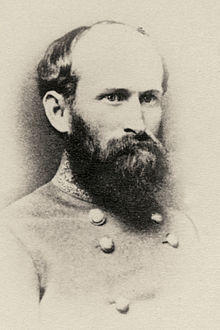- Martin Witherspoon Gary
-
Martin Witherspoon Gary (March 25, 1831 – April 9, 1881) was a brigadier general in the Confederate States Army during the American Civil War and a Democratic politician in postbellum South Carolina.
Contents
Early life and career
Born in Cokesbury, South Carolina, to Dr. Thomas Reeder Gary and Mary Ann Porter, he received his primary education at Cokesbury Academy before enrolling at South Carolina College in 1850. However, his participation in the Great Biscuit Rebellion in 1852 resulted in his withdrawal from the state college and he graduated from Harvard in 1854. In 1855, he was admitted to the bar and began practicing in Edgefield.
Civil War
Gary was elected in 1860 to the South Carolina House of Representatives as a secessionist and when South Carolina seceded he joined The Hampton Legion as a captain of infantry. At the First Battle of Manassas, he was given control of the Legion upon the disablement of his superiors. By 1862 he had been elected lieutenant colonel of an infantry battalion in the Legion and was promoted to colonel when given control of a regiment. The Legion came under the command of General Longstreet and was active in the battles of Virginia through mid 1863 before being transferred to help the Army of Tennessee in the latter part of the year. Rejoining the Army of Northern Virginia in 1864, Gary was made a brigadier general of a cavalry brigade in the Legion. He refused to surrender with General Lee at Appomattox and instead led 200 men of his brigade to escort President Davis and his cabinet from Greensboro, North Carolina, to his mother's house in Cokesbury where he ended his service as a Confederate soldier.
Postbellum activities
 Martin Gary as a State Senator
Martin Gary as a State Senator
After the war, Gary resumed his law practice in Edgefield and pursued a number of other business ventures. Fed up with the Radical Republican government which allowed the African-American majority in the South Carolina population to have a say in the government, he became an outspoken racist, saying on one occasion "that the negro shall not become a part of the body politic, or from any qualification either as to education or property, be allowed to vote in this country."
In the summer of 1876, Matthew Calbraith Butler wrote to his former commander, Wade Hampton, urging him to seek the governorship in the upcoming election. Butler omitted the details of the violent campaign planned by Gary and others, and Hampton accepted. Two years later Gary claimed credit for convincing Hampton to run. It soon became apparent that Hampton did not support Gary's campaign plan, a modified version of the Mississippi Plan or the Shotgun Policy. It was known in South Carolina as the "Edgefield Plan" due to Gary's leadership in its design and implementation. It called for the bribery or intimidation of African-American voters by local Democratic "rifle clubs" or "Red Shirts" formed ostensibly to attend campaign events and to insure order at polling places. Soon Red Shirt tactics became so violent that the state Democrats repudiated their association with Gary. After the election it was clear that Gary's tactics had helped Hampton to win, but it was also apparent that Hampton had won the trust of many black voters by his own actions.
The efforts of Gary's Red Shirts were evidently too successful in Edgefield and Laurens Counties, where Hampton received more votes than there were adult males. The election returns from these two counties were challenged and the outcome was critical to the decision of whether Democratic candidate Wade Hampton or the incumbent Republican Governor Daniel Chamberlain would serve the next term as governor. Hampton's victory came as the result of a deal between SC Democratic leaders and the national Republican Party. In April 1877 Republican candidate Hayes received the hitherto contested votes of SC electors and was finally declared the winner of the contested United States presidential race. In return, he then ordered the removal of Federal troops from South Carolina, ending the military occupation that had supported Radical Republican rule.
Gary then became a senator from Edgefield County and he was reelected in 1878. During his time in the State Senate, he became a vocal opponent of Governor Hampton because Hampton blocked his appointment to a U.S. Senate seat in 1877 and 1879. In addition, Hampton and his allies prevented Gary's candidacy in the gubernatorial election of 1880. Upon leaving the South Carolina Senate in 1881, Gary returned to his family home in Cokesbury where he died on April 9.
References
- Drago, Edmund L. (1998). Hurrah for Hampton!: Black Red Shirts in South Carolina during Reconstruction. University of Arkansas Press. ISBN 1-55728-541-1.
- Edgar, Walter (1998). South Carolina: A History. University of South Carolina Press. ISBN 1-57003-255-6.
- Reynolds, John S. (1969). Reconstruction in South Carolina. Negro University Press. ISBN 0-8371-1638-4.
- Williams, Alfred B. (1935). Hampton and his Red shirts; South Carolina's deliverance in 1876. Walker, Evans & Cogswell Company.
Martin, Samuel J. (2001). Southern Hero: Matthew Calbraith Butler, Stackpole Books, 2001, ISBN 0-8117-0899-3. Andrew, Rod Jr. (2008). Wade Hampton: Confederate Warrior and Southern Redeemer, University of North Carolina Press, 2008, ISBN 978-0-8078-3193-9.
External links
Categories:- Harvard University alumni
- Confederate States Army generals
- People of South Carolina in the American Civil War
- 1831 births
- 1881 deaths
- Members of the South Carolina House of Representatives
Wikimedia Foundation. 2010.

